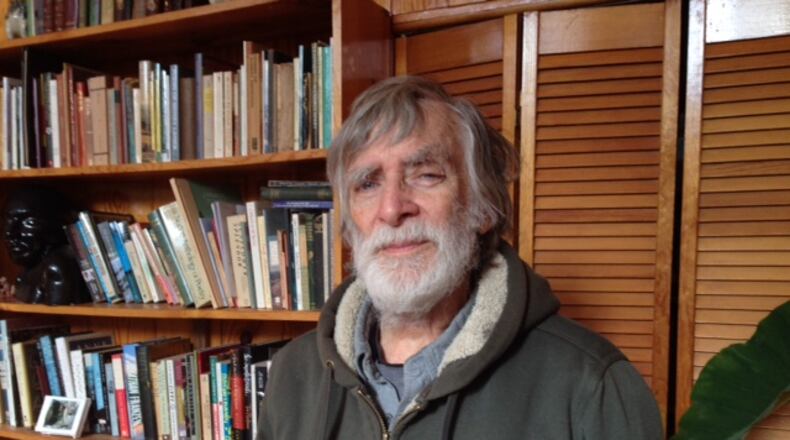The Almanack Horoscope (Time Watching)
For the First Week of Late Fall
Moon Time: The Apple Cider Moon enters its final quarter at 3:36 p.m. on November 10. Rising after midnight and setting in the afternoon, this moon passes over Clark County in the morning..
Sun Time: Sunset time varies by less than a quarter of an hour between November 14 and December 31.
Planet Time: Mars in Virgo is the red morning star, higher than both Venus and Jupiter. Venus disappears from the sky on November 13.
POOR WILL’S ALMANACK: Daylight Saving Time comes to an end
Star Time: By the end of the week, Procyon of Canis Major is just over the horizon at midnight. The Great Square has moved into the western half of the sky, Cygnus leading the way. Winter's Pleiades are well up in the east, followed by Aldebaran and Taurus. Cassiopeia is now due south of Polaris.
Shooting Star Time: Plan to watch the Leonid meteors after midnight on the 17th and 18th. The dark moon will favor viewing of those shooting stars.
Weather Time: The November 11 Front: Sun often follows this front and may provide some of the best days in the first half of the month for harvest. But if a killing frost has not occurred yet, the morning following this front may be the one to put an end to tender plantings.
The November 16 Front: As this front approaches, expect milder conditions, but an increased chance for precipitation. (Precipitation is now as likely to fall in the form of snow as in the form of rain.) After the front moves through, favorable harvest conditions typically follow. New moon on the 18th will increase the chances for frost.
Zeitgebers: Events in Nature that Tell the Time of Year: Climbing bittersweet opens in the woods. Hardy forsythia leaves are giving way to the cold and rain. Sugar maples, burned by frost, gradually drop their foliage.
Throughout the nation, practically all weeds and wildflowers become dormant. Only in subtropical Florida do Bermuda and Johnson grass, chenopods and amaranths continue to bloom.
Mid-November usually bring the height of rutting season for white-tailed deer. Their activity level increases during courtship, especially during nighttime hours. This often means an increase in automobile accidents involving deer.
POOR WILL’S ALMANACK: Peak leaf color begins
Farm and Garden Time: Clean up all around the yard and garden, cut your wood, clear out the hedgerows and haul manure. Plant next year's sweet peas for early April sprouting. Mulch perennials. Finish repairs to outbuildings.
Soil temperatures fall into the lower 50s, the point at which mulch can be placed around plants and bushes. In the garden, mulch strawberries with straw. Purchase and prepare seeds and flats for the first bedding plant seeding of 2018 (next week).
Marketing Time: Continue to market Indian corn, pumpkins and gourds at farmers' markets and roadside stands. Show off hand-made Christmas cards in your displays; they are often more appealing than standard store-bought cards. Include one free to your customers.
POOR WILL’S ALMANACK: Full moon could bring frost
Mind and Body Time: Leaf fall continues to impact your mood throughout the period, and the radical changes in the landscape may be significant in how you feel, especially as the holiday season approaches. Light therapy and art therapy are often useful antidotes for the November blahs. Explore how they might benefit you.
Creature Time (for fishing, hunting, feeding, bird watching): The moon will pass overhead before dawn this week, making early morning the best lunar time to look for food, especially as the cold fronts of November 11 and 16 approach (but not after they pass through.
Birds continue to migrate. Watch for the last plovers, willets, yellowlings and sandpipers to be traveling south. Major leafdrop of most hardwood trees has occurred by this time in the year, but foliage of the undergrowth may still complicate looking for game until well into December. Butterflies still come out on warmer, sunny afternoons, and sometimes a Monarch will pass through your yard on the way south.
POOR WILL’S ALMANACK: First chance for snow flurries
Journal
November 7, 2016: I rest in a blue lawn chair in the afternoon sun looking at the zinnias that have survived to this point in the autumn. Instead of thinking, I look for what lies nearby. Around the zinnias, flowers of the New England asters are gray, round tufts of seeds. Only a few light frosts have occurred so far this month, and the elephant ears and castor bean plants remain vigorous.
I am watching for butterflies and bees, nursing a small water glass of white wine. First comes the silver-spotted skipper, inconspicuous brown, fitting easily with the browning leaves and stems of the zinnias. A few bumble bees travel from flower to flower, lighting for only a moment before moving on. Then a bright yellow sulphur rises out of the bushes and flies to the top of the wisteria that has grown across the garden trellis, remaining there to bask in the sun.
Then comes a cabbage white zigzagging across the tops of the flowers, uninterested, it seems, to land and check for flowers. Behind me on the bird feeders, the sparrows cluster, then burst up at the smallest sound, then fly back to eat, then explode again, then fly back again. As I am about to leave, a female deer moves quietly through the wooded border between my garden and the neighbor’s just a few yards from me.
Poor Will’s Almanack for 2018 is now available. Order yours from Amazon, or, for an autographed copy, order from www.poorwillsalmanack.com.
About the Author
